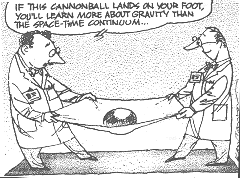
 |
Arthur C.Clarke,the futurologist and author of 2001:A
Space Odyssey,once declared that when distinguished but elderly scientist
states that something is possible,he is almost certainly right,but when he
states that something is impossible,he is very probably wrong.
It is not hard to find cases to back Clarke's dictum.The Nobel
Prizewinning physicist Ernest Rutherford,the founder of nuclear physics,once
declared that talk of nuclear power was "moonshine",while in 1957 Britain's
Astronomer Royal,Sir Harold Spencer Jones,dismissed the idea of space flight
as "bunk" -just two weeks before the Soviet Union launched Sputnik 1.
Most such blunders have at their heart the underestimation of human ingenuity.The
brilliant American Astronomer Simon Newcombe can surely be forgiven for
describing the idea of aircraft as "utterly impossible",as even today it
is possible to find aircraft engineers who cannot explain why fixed wing
machines stay aloft.
To many,the very thought that there might be theories about
what space and time are "like" will seem pretty mind-bending.Yet it is currently
one of the hottest research topics in theoretical physics,attracting some
of the very best minds to push beyond where even
Einstein dared not go.
The commonsense view of space and time is of an arena in which events take
place.Einstein's most profound discovery was that the "floor" of this arena
need not be absolutely flat:put a lump of matter in it and it buckles under
the weight,like a rubber sheet bearing a cannonball.
This bending of space and time,according to Einstein,is the cause of gravity.For
example,the Earth -roughly speaking - creates a dimple in the space and time
around it,down into which
Newton's famous apple rolled when if fell
off the tree [Some people suggest Newton's apple is a myth-LB].
Yet while Einstein gave us equations that describe how space
and time behave,he said nothing about what space and time actually are.Just
what is it that is being warped and bent? Physicists have long been tantalised
by a back-of-the-envelope calculation carried out many years ago that hints
that if one could look at space and time close enough,they would no longer
appear perfectly smooth. Instead,they would appear to be a
seething mass of loops and whorls of energy,
constantly popping in and out of existence.
Many physicists are entranced by this vision of what one leading
theorist has dubbed "space-time foam".But they are soon brought back to reality
by the very same back-of-the-envelope calculation that predicts its
existence.This shows that space-time foam only shows itself on scales a thousand
billion billion times smaller than an atomic nucleus.
It is virtually impossible to comprehend something so small:one
vaguely helpful analogy is to say that to "see" space-time foam,one would
have to magnify an atom until it was bigger than the distance from the Earth
to the nearest stars.One thing seems clear,however: no one is going to detect
space-time foam any time soon.
Last month,however,an international team of scientists made
the astonishing claim that it may already be possible to find out quite a
lot about what is happening down at the level of space-time foam.
The trick lies in exploiting the colossal amounts of energy
released by explosions in distant galaxies known as gamma ray bursts.Triggered
by,for example,two black holes smashing into one
another,these bursts are thought to be the most violent events in the universe
- so violent,that they could reveal the nature of the "fabric" of the space-time
around them.
That,at least,is the claim of Giovannu Amelino-Camelia of the
University of Neuchatel in Switzerland and his colleagues.In the journal
Nature,they claim that radiation zooming
out from a gamma ray burst is affected by the fabric of space-time creating
a measurable time-delay on its journey from the explosion to the Earth.By
measuring this time-delay,the team claims that it may even be possible to
see which theories of space-time foam actually best fit reality.
The mere possibility of being able to carry out experimental
tests of such mind-boggling theories is enough to shock even the most sanguine
theoretical physicists.Yet as the history of science shows,the motto is "Never
say never".
Robert
Matthews
Further Reading |
| Universe from nothing |
| Chaos | Quantum | Logic | Cosmos | Conscious | Belief | Elect. | Art | Chem. | Maths |